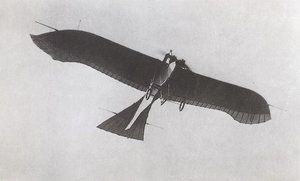Rumpler Taube
|
|
| Rumpler Taube | ||
|---|---|---|
| Description | ||
| Role | Fighter, Bomber, Surveillance, and Training | |
| Crew | 2 | |
| Dimensions | ||
| Length | 33.5 ft | 9.9 m |
| Wingspan | 45.83 ft | 14.3 m |
| Height | 10.5 ft | 3.2 m |
| Wing area | 280 ft² | 32.5 m² |
| Weights | ||
| Empty | 950 lb | 650 kg |
| Maximum take-off | 1200 lb | 850 kg |
| Powerplant | ||
| Engines | 4-Cylinder Argus or 6-Cylinder Mercedes Typ E4F | |
| Power | 74 kW | |
| Performance | ||
| Maximum speed | 60 mph | 100 km/h |
| Range | 140 km | |
| Service ceiling | 10,000 ft | 2000 m |
| Armament | ||
| Guns | Rifles and pistols | |
| Bombs | Hand dropped bombs | |
The Rumpler Taube is a pre-World War I monoplane aircraft, and the first mass produced military plane in Germany. Being the Germans' first practical military plane, it was used for all common military aircraft applications, including as a fighter, bomber, surveillance plane and trainer from its first flight in 1910 until the beginning of World War I. Due to the rapid advancement of aviation during the war, the design was obsolete by 1914.
The plane was developed by lgo Etrich from Austria in 1909, with the first flight in 1910, and called Etrich Taube. The design was licensed for serial production by Lohner in Austria and Rumpler in Germany, and called Etrich-Rumpler-Taube. However, Rumpler soon changed the name to Rumpler-Taube, and stopped paying royalties to Etrich. Etrich subsequently abandoned his patent. Due to the lack of license fees, a total of no less than 14 companies built a large number of variations of the initial design, making it difficult for historians to determine the exact manufacturer based on historic photographs. An incomplete list is shown below. The most common version was the Rumpler Taube with 2 seats. The plane was very popular, and used by the air forces of Italy, Germany and Austria-Hungary.
- Albatros Taube, by the Albatros Flugzeugwerke
- Albatros Doppeltaube, biplane version by the Albatros Flugzeugwerke
- Aviatik Taube
- DFW Stahltaube, also known simply as Stahltaube, with a steel frame
- Etrich Taube, produced by the inventor Igon Etrich
- Etrich-Rumpler-Taube, initial name of the Rumpler Taube
- Gotha Taube, by the Gothaer Waggonfabrik
- Harlan Pfeil Taube
- Halberstadt Taube III
- Jeannin Taube, also known as Jeannin Stahltaube, with a steel frame
- Kondor Taube
- Luedemann Taube
- RFG Taube, produced by the Reise- und Industrieflug GmbH (RFG)
- Roland Taube
- Rumpler-Taube, produced by Edmund Rumpler, Luftfahrzeugbau
- Rumpler Delfin-Taube, also known as Rumpler Kabinentaube "Delfin", with a closed cabin, produced by Edmund Rumpler, Luftfahrzeugbau
Despite its name, the Taube (German: dove) was not modeled after a bird, but after the Zanonia macrocarpa seeds, which glide to the ground in a slow spin induced by a single wing. Similar wing shapes have also been used by Karl Jatho. While Etrich had tried to build a flying wing aircraft based on the Zanonia wing shape, the conventional Taube was much more successful.
Most notably, the plane did not have a rudder in the tail or ailerons in the wings. Instead, the pilot turned the plane by warping the wings (effectively providing the same functionality as ailerons) and using the elevators at the rear of the tail.
The design provided for very stable flight, suitable for observation. In addition, the translucent wings made it very difficult for ground based observers to detect a Taube at an altitude above 400m. The French called this plane also "the Invisible Aircraft", and it is sometimes also referred to as the "world's very first stealth plane". The first hostile engagement was an Italian Taube in 1911 in Libya, using pistols and 2 kg bombs. Taube airplanes were able to detect the advancing Russian army during the Battle of Tannenberg (1914). The plane was also used for bombing, when the pilot dropped small bombs in the Balkans in 1911 and 3 kg bomblets and propaganda leaflets over Paris in 1914.
However, the lack of a rudder and the wing warping design made this plane difficult and slow to turn. Subsequently the plane was a very easy target for the faster and more mobile enemy planes at the beginning of World War I. Therefore, 6 months into the war, the Taube was removed from the front lines and instead used to train new pilots. Consequently many famous pilots learned how to fly using a Taube.
See also
Resources
- Erich Taube (http://www.ctie.monash.edu.au/hargrave/etrich_taube.htm)
- Rosebud's Archive with many Photos (http://www.members.shaw.ca/flyingaces/archive1.htm)
- Rumpler Taube Flight History (http://www.flight-history.com/arch/showstory.php?contentID=63)
|
Lists of Aircraft | Aircraft manufacturers | Aircraft engines | Aircraft engine manufacturers Airports | Airlines | Air forces | Aircraft weapons | Missiles | Timeline of aviation |



